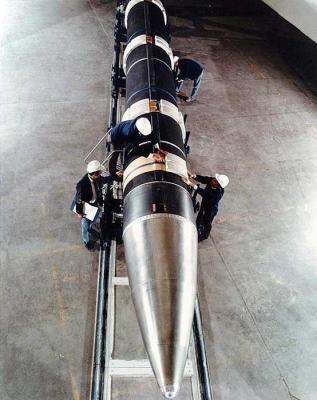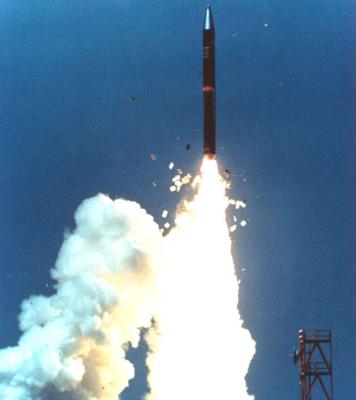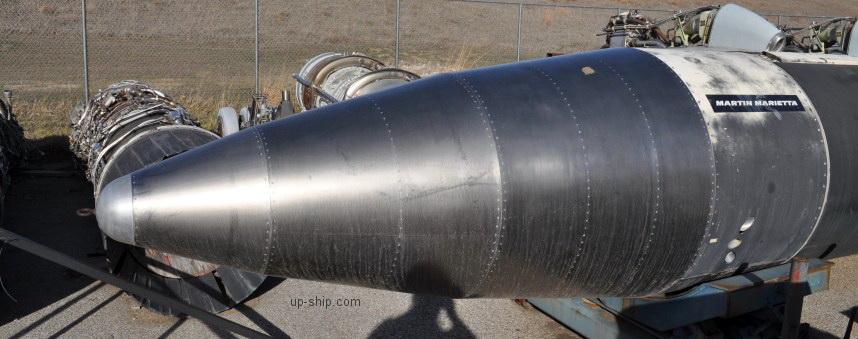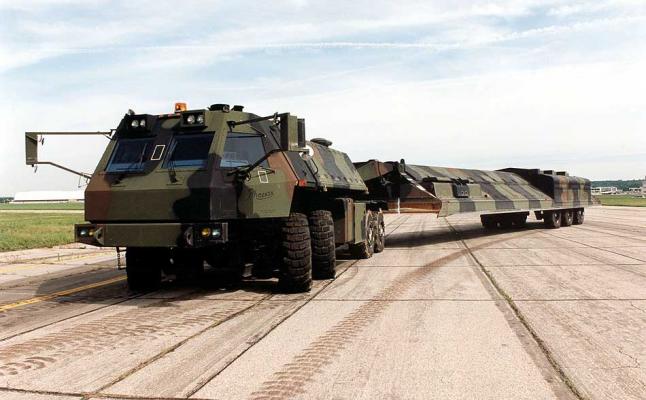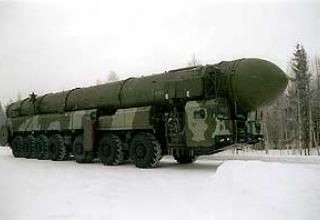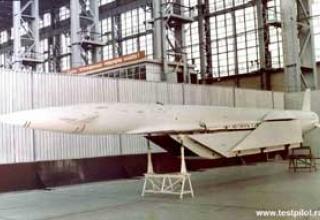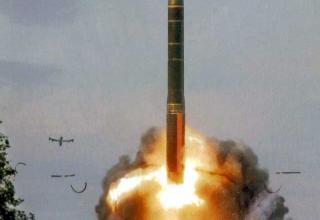In January 1983, President Reagan established an independent commission chaired by Lieutenant General B. Scowcroft to study the development prospects of the U.S. SAC ICBM group for the period up to the end of the XX century. The commission's verdict was made public in April 1983. One of the results of the commission's work was the conclusion that in order to meet the Air Force SAC's needs for a promising, relatively low-cost, highly survivable ICBM, it was necessary to develop "small, solid-fuel, monoblock and high-precision mobile ground-based ICBMs. Other deployment options for this ICBM have been proposed. A few days after the release of the results, President Reagan endorsed the findings of the Scoucroft Commission. In May of the same year, the Commission's findings were approved by the Senate and the U.S. House of Representatives. In August 1983, it was approved by the Senate and the U.S. House of Representatives. Minister of Defense Weinberger decided to immediately begin to develop specific engineering requirements for SICBM ("Small Intercontinental Ballistic Missile") - under this acronym was encoded new project. Work on the shape of the future missile began in January 1984 and was conducted under the leadership of BMOH ("Ballistic Missile Organization", Headquarters of), Norton Air Force Base (California). In the same year, work began at Hill Air Force Base, Utah, at the Air Force's Ogden Logistics Center, to build specialized SICBM test stands. From the very beginning, it was decided to use only promising structural materials, high-energy solid fuels with octogen addition, similar to those used on the upper stages of the Peacekeeper ICBM, and the most advanced electronics to create the new missile. It was decided to "unload" the missile as much as possible by abandoning the anti-missile defense SLCM, the mass of combat equipment was to be 450 kg. According to experts' calculations, the weight of the future missile should not exceed 15.42 tons.
But already in October 1985 it became clear that during the calculations it was allowed to re-evaluate the state of the U.S. solid fuel missile base at that time, and in March 1986, the General Staff of the SAC Air Force issued revised requirements for the prospective missile, including taking into account its equipment KSP missile defense. In December of the same year, President Reagan approved the start of full-scale development of the SICBM mobile ground-based ICBM weighing 16.78 tonnes. The new missile received a preliminary index XMGM-134A, and its own name "Midgetman" was assigned to it. The missile's guaranteed service life was to be 20 years. It was planned to use either lands belonging to the Ministry of Defense and the Ministry of Energy ("principle of free duty" of mobile PU with their movement from time to time on areas by random law) or already existing air bases as basing places, where Minuteman ICBMs were deployed (Malmstrom, Ellsworth, Minot, Whiteman, Grand Forks), where PPs were to be on standby duty in shelters, entering routes on higher alert, thus allowing partial use of existing infrastructure and significantly reducing financial and resource costs of equipment. The option of deploying new missiles in ultra-strength SLCMs was also considered. The first and last basing options were rejected after consideration, as were the options to equip a 2B rocket with individual guidance (Mobileman program). The first missiles were to reach the alert status in December 1992. By the end of June 1999 it was planned to deploy at least 500 XMGM-134A ICBMs, which were to replace the LGM-30F "Minuteman-II" and LGM-30G "Minuteman-III" ICBMs and complement the LGM-118A "Peacekeeper" ICBM group, which was planned to be fully deployed by that time.
Work on the rocket from the beginning was carried out on a competitive basis - for the role of the main contractor competed aerospace industry giants such as "Boeing", "General Dynamics / Convair", "Martin Marietta", "McDonnell-Douglas". The contracts for the development of RTDTs for all stages of the march were also the subject of intense competition on the basis of the "one stage, two contractors" principle: Morton Thiokol and United Technologies/Chemical Systems Division - stage 1, Aerojet and Hercules - stage 2, Hercules and United Technologies/Chemical Systems Division - stage 3.
In June 1985, Martin Marietta Corporation was chosen as the head contractor, which was to develop an autonomous dilution unit and provide testing and the entire life cycle of the missile, Thiokol, Aerojet-General, Hercules-Aerospace Production Group corporations in December 1986 received contracts for the development of RDTT 1-stage, 2-nd and 3-rd stage, respectively. In addition, Thiokol took up the task of creating an in-flight missile elimination system, and Hercules-Aerospace Production Group took up the task of igniting the RDTT flight stages. The combat unit was developed by AVCO, the combat unit - by Lawrence Livermore National Laboratory, and the full-scale integration of combat equipment was done by Sandia National Laboratories. The "Modified Advanced Inertial Reference Sphere" (Mod AIRS) control system based on the AIRS missile Peacefulkeeper was developed by the Autonetics ICBM Systems Div. division of Rockwell International. At the initial stage, due to the low reliability and high cost and complexity of this AIRS, alternatives to the so-called Alternative Inertial Navigation Systems (AINS) - based on laser gyroscopes (2 versions, by Honeywell and Litton) and astroinertial AIRS, similar to those used on Trident SLBMs (by General Electric) - were also considered. As the reliability and performance of Mod AIRS was brought to the required level, all AINS variants were consistently rejected by early 1988. In order to reduce costs (in 1986 alone, the SICBM program was increased by 136% compared to the previous year, 1985) and to reduce the share of technically risky solutions, the existing scientific and technical reserve obtained from the MX and Trident II D5 programs was maximized.
The development of combat equipment (combat unit W-87-1 with an output of 475 kt) for the new missile began at Lawrence Livermore National Laboratory in November 1987. The new BC was planned to be placed in the Mk21 combat unit, to reduce the cost of the program borrowed from the LGM-118A "Peacekeeper" ICBM.
Work on the mobile PU since September 1983 was also carried out on a competitive basis, and in February 1984 were announced the names of companies allowed to the main part of the competition - the main contractor wanted to become "Bell Aerospace/Textron", "Boeing Aerospace", "Martin Marietta", "General Dynamics". After reviewing the proposed projects in early 1985, initial contracts for the development of mobile launcher prototypes were also awarded to Martin Marietta and Boeing Corporation on a competitive basis. The prototypes of HML ("Hardened Mobile Launcher") developed by these companies were presented to the public in September 1985 and arrived for comparative testing at Malmstrom Air Base in January 1986 (see photo of prototypes of mobile launchers of Martin Marietta and Boeing corporations). As a result of the tests, the installation (see photo) developed by the Aerospace Electronics division of the Voying Corporation was chosen. The same contractor took on the development of the control system for the entire missile system, bypassing competitors such as Martin Marietta and Ford Aerospace. Subcontractors for HML development were Defense Systems Division of Loral and Rolls-Royce Perkins. A modified version of this unit (ETU - Engineering Test Unit), which had its own name "Phoenix", arrived at Malmstrom Air Base for further testing in December 1988. The Phoenix was first tested autonomously, later on it was equipped with an ICBM transport electro-machine.
The development of the "mortar" launch of the rocket from the TPK mobile PU was carried out in 1987 during the runaway tests of the mock-up of the ICBM on a special stand of the range "Nevada Test Site". The work to determine the degree of stability of the developed mobile PU to foammable substances was carried out jointly by Martin Marietta, Boeing, Air Force Weapons Laboratory (AFWL), Sandia National Laboratories and Defense Nuclear Agency (DNA) - first of all, the stability of the complex to such foammable substances as a shock wave was assessed. Both experimental laboratory facilities (AFWL and Sandia shock tubes) and a full-scale experiment - a special non-nuclear explosion at the White Sands Test Site conducted by the DNA in June 1985 (see photo) with a capacity of 4 kt TE - were used for this purpose, which was equivalent to an eight-kiloton nuclear warhead detonated in the air. A security system for mobile PU was developed by the New Mexico Institute of Mining and the Technology TERA Group in 1985.
The issue of reducing the total cost of the program for developing a new missile was extremely important - in February 1988, the U.S. Secretary of Defense proposed to close the program due to the high cost compared to other alternatives, but this proposal was not supported - it was decided to continue work and allocate funds for this purpose for the 1989 fiscal year, ie shifting the burden of making the final decision to the next presidential administration. However, already in April 1988 the financing was sharply reduced - the allocated funds were enough only to continue the research and development work primarily on the missile itself and the production of two flight models, so it was no longer a question of putting the first missiles on combat duty in December 1992. The development of the new MS was discontinued. It was planned to close the program definitively in September 1989 after obtaining results suitable for the future development of promising strategic missile systems. However, in April 1989, the U.S. Department of Defense, having revised its previous position, requested funds to resume full-scale work on the new system, but due to the difficult financial situation for 1990-1991 financial years, funds were still allocated primarily for research and development of the missile itself, for further work on mobile boost-phase control, combat equipment of the missile (primarily a new BC), the combat control system, a detailed analysis of several aspects of the methods of deployment of the complex and actually for the beginning of production of missiles on a scale suitable for the missile. As an illustration, one can mention the fact that back in August 1990 the Ministry of Defense was unable to finally decide either on the basing method for new missiles or on the number of missiles actually planned for deployment. At the beginning of 1991, the Ministry of Defense asked for $548.2 million for the fiscal year 1992 - only in this case, according to the military, it was possible to begin mass work in that year to put the first missiles on duty no later than December 1997, and it was also possible to produce a third flight missile and put it on flight tests no later than the second quarter of 1993 with a further serial production of missiles in January 1995 and the first launch from the regular mobile PU in 1996. The total cost of the entire program to put 500 missiles on three Minuteman bases in December 1997 - December 2008 was estimated in December 1990 at 41.9 billion dollars. For comparison, in July 1987 the cost of the entire program was estimated at $24.2 billion, an increase of more than 73%. However, at congressional hearings held in February-March 1991 on the defense budget, the military unexpectedly announced that they planned to continue developing the new complex, but there were no plans for its deployment even as of 2000. In March of the same year, the SAC Commander stated that the Midgetman missile was primarily considered a replacement for the Minuteman III missile, but given the plans announced in 1990 to operate the latter until 2008, it was clear that the need to deploy the Midgetman was not obvious until 2008.
Both manufactured flight missiles were originally planned to be launched in 1989, in May and November, respectively. The first test launch of a new missile was made from a ground launch container at Vandenberg Air Base (California) in May 1989 and ended (in terms of American experts) "partial failure" - the rocket successfully came out of the container, launched and worked off the first stage engine, then the first stage separated in normal mode, there was a launch of the second stage engine. However, in the area of the second stage the nozzle block was destroyed and the rocket was eliminated on command from the Earth. The problems, judging by the published data, were caused by the use of inappropriate materials in the manufacture of the nozzle block. It took one and a half years to analyze the incident and refine the rocket - the second and last produced flight rocket took its place in the launch container in November 1990. Initially, preparations for the launch were successful, but shortly before the launch the rocket automatically withdrew from readiness - the reason was the failure of power supply elements of the rocket elimination system when transferring the rocket from ground to onboard power supply. The next launch attempt took place in April 1991 and was successful. The launch was a complete success, and the combat unit got into the specified area of the Pacific Ocean (Kwajalein Atoll), according to military reports, the accuracy achieved exceeded the set targets. There were no more manufactured flight missiles at the disposal of testers.
By spring 1991, due to a dramatic change in the geopolitical situation in the world, further implementation of previously planned programs to improve the U.S. strategic nuclear missile weapons (primarily Midgetman and Peacekeeper Rail Garrison) was put into question. The START I Treaty was signed in July 1991, and in September of the same year President J. Bush urged to stop further allocation of funds for a number of military programs, including the mobile version of the Midgetman ICBM. Work continued for some time on the option of stationary placement of XMGM-134A ICBMs in the modified mines of Minuteman ICBMs (this option began to be considered since early 1991). But already in January 1992 the program was finally shut down and the scientific and technical reserve obtained during its implementation was put on hold.
It is necessary to note, that the reduction of financial resources for this program, observed for a number of years, causes doubts in the ability and, first of all, the desire of the USA to really deploy this system. For example, the results of the financial audit of the program published in September 1991 showed that the specific requirements for the deployment of new missiles have not been worked out, and even taking into account all the funds planned by the Defense Ministry for the SICBM program "for the future" in 1992-1997 financial years, the deployment of the first missiles in December 1997 is an unrealistic task, because the required 6.1 billion dollars even in the plans was not fully budgeted. It can be assumed that the SICBM program was one of those military and scientific-technical programs, with the help of which the US for a number of years provoked the USSR to develop similar expensive weapon systems. At the same time, the implementation of such programs, even on a limited scale, gave the US, in addition to the means of military and political pressure, the possibility of broad financing of a number of scientific and technical programs of the so-called "far perspective".
Composition:
The XMGM-134A "Midgetman" ICBM is a solid propellant three-stage missile whose stages are connected in a longitudinal pattern (see layout). All three marching steps were made of graphite epoxy material used in the Trident II D5 SLBM by winding and had a black multifunctional coating on the outer surface, protecting the missile from the effects of fossil fuels and aerodynamic heating. The same coating was applied to the bodies of the tail and transition compartments as well as to the ADB. The coating was about 6 mm thick and was a rubber-like material with a base made of ethylene propylendium monomer. The new structural material used for RDTT bodies promised a significant reduction in the inert mass of RDTT and the possibility of significant pressure increase in the combustion chamber (>10 MPa at the 1st stage, 9 MPa at the 2nd stage, 6 MPa at the 3rd stage) as compared to Kevlar-epoxy materials used in Peacekeeper rocket.
Each stage (see Photo1, Photo2, Photo3, Photo4, Photo5, Photo6, Photo7) had one central, partially recessed into the combustion chamber, a deflected nozzle, which made it possible to control the missile through the channels of pitch and yaw. The whole cocoon-nozzle was made of a special carbon-carbon material with 3-dimensional orientation of reinforcing fibers and a given distribution of such properties as thermal conductivity, erosion resistance, etc. over the volume of the material, which made it possible to improve the energy mass perfection of engines. The optimal method of manufacturing such material was developed within the framework of the MANTEC research program initiated by the Air Force (MANufactirung TEChnology). Nozzles of the second and third marching stages were equipped with a retractable conical nozzle on the nozzle body. This solution made it possible to provide the required degree of nozzle expansion (and, accordingly, the maximum engine thrust) while reducing the dimensions of the rocket. The missile was controlled by the roll channel only in the area of the third march stage operation, for which the autonomous breeding unit (ADB) remote control was used. All stages used the latest high-energy solid propellant of "detonating type" (Class 1.1), created on the basis of solid propellant used on the Trident-II D5 SLBM and partially on the LGM-118A "Peacekeeper" ICBM. In order to minimize the inertial mass of the missile, it was decided to use innovative design approaches as well - in particular, the ADB hull and transition compartments of the 1st and 2nd stages were made of graphite epoxy materials, which allowed to reduce the inertial mass of the structure by 40% as compared to aluminum alloys traditionally used for this purpose. At separation of marching steps transition compartments for the purpose of efficiency increase remained on a detachable step. At the 3rd step the transitional compartment between a step and ГЧ has been abolished, and its role was played by the elongated forward skirt of RDTT. There was no thrust cut-off system on the rocket, and range control was carried out by changing the pitch angle with full fuel production of all marching steps. Abandonment of the traditional cable network was also innovative - it was planned to use fiber optic lines. Instead of traditional pyrotechnic ignitors for RDTT marching stages, it was planned to use laser ones.
The head part of the missile was a combat equipment and an autonomous dilution unit with its own remote control, covered during the launch and up to a height of 90-100 km with a triconical titanium (niconelloy tip) head fairing, which was removed after separation by a special RDTT in the nose of the fairing. At the top of ADB, a special platform was provided for one Mk21 BB (see photo). The combat unit was separated from the platform to which it was attached by triggering special "gas cartridges" (designed for LGM-118A ICBMs) - this made it possible to separate the AB from the platform with minimal disturbance to achieve increased accuracy. No data is available on the composition and placement of the ABI MAC, which was part of the combat equipment. The HC control was designed for precise control of the HC speed after its separation from the missile, stabilization and orientation of the HC until the deployment of combat equipment, and to control the missile flight on a roll channel in the area of the third stage. The remote control traditionally included a high thrust marching engine and low thrust orientation engines. The remote control is liquid, for its work for the first time was used mono-fuel - hydrazine. Fuel supply system - displacement.
The Modified Advanced Inertial Reference Sphere (Mod AIRS) control system (see photo) with an inertial unit and an on-board Digital Computing System (OBDCC) was located in a special compartment at ADB. The BCVC provided flight control in the active section of the trajectory, during the deployment phase of the combat equipment, as well as during the on-duty and preparation for launch. The flight control system is cooled down with freon to create necessary temperature conditions. The rocket's electronics are made on radiation-resistant semiconductor electronics. The control system provided the rocket with very high accuracy (KVO, according to different data, from ~ 90 to 170 m). The Inertial Reference Sphere was a development of the Peacekeeper missile's SC, modified in terms of the design of the AIRS ("Advanced Inertial Reference Sphere") - its cooling system was significantly lightened and simplified, as the new missile had a significantly reduced active section of the trajectory with a very short stage of dilution of combat equipment. BCWC was also lightened by the use of new generation electronic components.
To ensure the launch of XMGM-134A, American designers used the so-called "mortar" scheme. The Midgetman ICBM launch complexes were supposed to be a four-axle tractor with a crew of two persons with a three-axle semi-trailer with the nuclear blast wave resistance up to 0.21 MPa (it allows to avoid destruction in case of explosion of a typical 500 kt thermonuclear warhead at a distance not closer than 1, 3 km), on which was placed in a horizontal position, closed by sashes of special armored steel with multifunctional coating on the inner part of the PU, transport and launch container made of new generation organic fiber. In the tests, the prototype of the mobile launcher - "Phoenix" showed a speed of 48 km/h on rough terrain and up to 97 km/h on the highway. The power plant is a turbocharged diesel engine with an output of 1200 hp, transmission - electro-hydraulic. When receiving a command to launch a rocket (see diagram), the tractor stopped, unloaded the semitrailer with the TPC on the ground and pulled it forward. Due to the presence of a special plough-like device, the semitrailer would self-loop, providing additional protection from the nuclear explosion (see diagram), for example, from tipping over under the influence of an air shock wave, after which the tractor would leave and all further actions were carried out automatically. Once the national nuclear command and control system had received the order for use from the remote command and control centre via live radio, the sashes of the semi-trailer were opened and the transport and launch container was tilted. The solid propellant gas generator located in the lower part of the container ejected a missile to a height of up to 30 m from the upper section of the TPC when triggered, after which the first stage marching engine was engaged. To reduce the error in determining the coordinates of the starting position of the MGRK had to be equipped with satellite navigation systems.
The missile was fixed in the transport and launch container by means of several rows of special polyurethane tiles (see photo) covered with teflon-like material. They served as shock absorbers and were automatically removed when the rocket left the container. During test launches, the missile was launched from a special launch container mounted on the Earth's surface in an inclined position.
It should be noted that not all adopted technical decisions proved to be optimal - in particular, improvements of a number of auxiliary elements of the nozzle blocks of the remote control and internal heat protection of the RDTT of all marching stages, as well as the nozzle blocks themselves on the 1st and 2nd stages were agreed upon. It was decided to abandon the graphite epoxy structure of the ADB hull, again using aluminum alloys, and to change the design of the platform on which the combat equipment was placed. All this was to result in an increase in the mass of the missile up to 17.28 tons with a decrease in the range to 11100 km.
Characteristics:
| Range of fire, km | 11 400 |
| The mass of the rocket is starting, t. | 16,78 |
| The length of the rocket is complete, m | 14,02 |
| The diameter of the rocket, m | 1,17 |
| 1st stage engine traction at sea level, kN | 979 |
| Stage 1 operating time, s | 60 |
| Weight of RDTT 1st stage assembly (without tail and connection compartments), t | 8,5 |
| 2nd stage traction in vacuum, kN | 227 |
| Step 2 operating time, s | 44 |
| Weight of 2nd stage RDTT assembly (without connection compartment), t | 3,2 |
| Weight of RDTT 3rd stage assembled, t | 1,5 |
| Type of military equipment | monoblock, thermonuclear HF, with CSP PRO |
| BB power, kt. | 475 |
| Weight of combat equipment, t | 0,55 |
| KVO, m | 90 |
| Weight of IBC (ETU) assembled, t | 108,41 |
| Maximum load-carrying capacity (ETU), t | 36,29 |
| Length BGRC (ETU), m | 34 |
Testing:
MTUR "Malyutka" was very successfully used during the Arab-Israeli War in 1973, it was with its help that almost the entire Israeli tank fleet was destroyed - about 800 vehicles. Only on October 6, 1973, for example, the 252nd Israeli Tank Division was defeated - more than a hundred vehicles were hit.
Sources:
- To defend and deter: the legacy of the United States Cold War missile program / J.C. Lonnquest and D.F. Winkler. USACERL, 1997
- SAC missile chronology 1939 – 1988 / Office of the historian. OH HQ SAC. 1990
- Malmstrom AFB: 1942-1992, 50th Anniversary, Great Falls, Montana / 341st SMW History Office, Malmstrom AFB, Montana, 1992
- А.А. Шумилин «Авиационно-космические системы США», 2005 Москва, «Вече»
- www.nationalmuseum.af.mil
- www.globalsecurity.org
- www.nuclearweaponarchive.org
- www.militaryparitet.com
- Вокруг света, №4 (2799), 2007
